For every famous Derby winning horse there are hundreds more who are inconsistent and a heck of a lot slower. Similarly, not every jumper can be in contention to win the Cheltenham Gold Cup, and will feel more at home trying to get around the course at Hexham on a Monday afternoon.
There are around 15,000 horses in training in the UK, and the gulf between the champions and the also rans is huge.
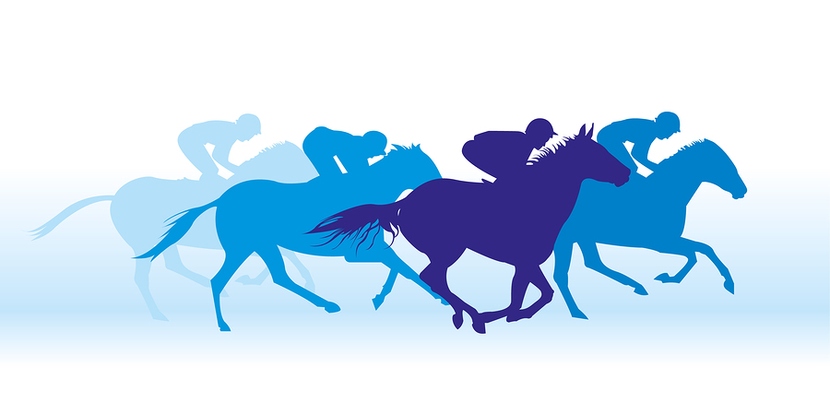
Race meetings are held almost every day of the year; the average day might see four or five meetings over the flat and jumps, at the weekend this can be higher still, and into double figures when it’s a Bank Holiday Monday. The vast majority of the races are lower level meetings with the higher-class races often at the weekend or at celebrated racing festivals such as Royal Ascot, Epsom and Newmarket on the flat, and at Cheltenham and Aintree over the jumps.
With so many different classes, it means owners are given plenty of chances to find a race in which their horse can compete and hopefully be competitive in.
The way in which the racing industry attempts to distinguish between horses of varying qualities is by using a rating system for the horses, and a grading system for the races. This can feel daunting if you have never investigated it before, but stick with us and you will become more familiar with what this all means.
The first thing to understand is that there are two different categories of horse racing in this country; flat racing and National Hunt racing. The grading system works differently for each, so the best thing to do is to split them up and look at each category in isolation.
Ratings
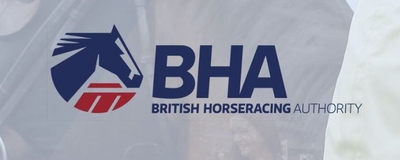 Before we get into the different race grades, it’s important to have at least a vague understanding of ratings, as these have an impact on what level of race a horse can compete in.
Before we get into the different race grades, it’s important to have at least a vague understanding of ratings, as these have an impact on what level of race a horse can compete in.
All horses have a rating determined by the BHA (British Horseracing Authority). The higher that rating is, the better that horse should theoretically be. The rating system works slightly differently for flat racing than it does for National Hunt racing, but don’t worry about that for now.
A horse gets an official rating after it has won a race, or after it has raced unsuccessfully three times and finished in the top 6 at least once. This rating will then be re-evaluated each week, so it can go up and down fairly often.
The rating is based on performance and gives an indication as to the handicap each horse should have.
Handicap?
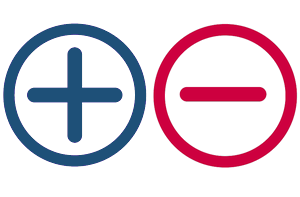 Yep, yet another term you should get to grips with.
Yep, yet another term you should get to grips with.
This one is nice and simple though; a handicap is used to even the field and hopefully make for a more competitive race.
Top performing horses will be made to run with extra weights (the handicap) in order to give the other runners in the race a fighting chance of winning. The amount of extra weight they carry is based on their rating, as well as the rating of the other horses in the race.
As a basic example, a horse rated at 110 will carry 10lbs more weight than a horse rated at 100. Simple.
Flat Racing
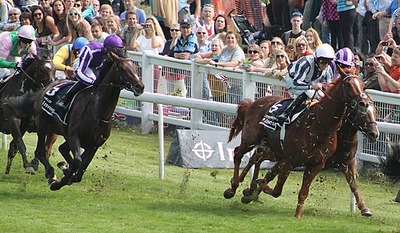
Now that we understand that, let’s first take a look at flat racing.
Anyone who has ever seen the horses going downhill at Epsom will appreciate that the term ‘flat racing’ shouldn’t be taken literally. It simply refers to races that don’t include any jump fences or hurdles.
The minimum distance for a flat race in Great Britain and Ireland is five furlongs. Those horses that have a lot of stamina can take part in longer-distance races that are over two miles.
Flat racehorses don’t tend to compete for as long as jump racehorses. They will be in their prime between 3 and 5 years old on average, then they will retire early and be put out to stud. If they have done well in their racing careers they can command a huge fee for this ‘work’, the idea being that you are buying the superior animal’s gene’s and so your mare will produce a future champion.
The top flat races are known as the Classics because they have been run over hundreds of years – you might have heard of some of them:
| Race | Date | Course | First Run |
|---|---|---|---|
| 2,000 Guineas | April/May | Newmarket | 1809 |
| 1,000 Guineas | April/May | Newmarket | 1814 |
| Epsom Oaks | June | Epsom Downs | 1779 |
| Epsom Derby | June | Epsom Downs | 1780 |
| St. Leger Stakes | September | Doncaster | 1776 |
Flat Racing Grades
Flat races are broken down into Groups and Classes. Group races are the most prestigious and only the best horses are allowed to compete in these. They are spread out over the summer and treated more as special events, especially those in Group 1 like the Classics.
There are three groups:
| Group 1 | Group 2 | Group 3 |
|---|---|---|
| Top level international, official rating of 115+, 36 races in total | Second tier, official rating of 110+, 49 races in total | Third tier domestic, official rating of 105+, 73 races in total |
After this, you start to deal with the different classes. This is the day to day racing that you find in the back of the daily newspaper. It’s where all horses earn their stripes and can be thought of a little bit like the football leagues; the better teams/horses compete in the higher leagues/classes. It is a lot more fluid though, and there is some crossover.
All races are put in a class from 1-7. Official ratings play a part in deciding which horse races where, but there are also specific race types that belong to certain classes and have their own rules attached. We won’t go into those today as it can easily become overwhelming, but as an example; Maiden races are for horses that have never won a race before, but eligibility can be based on age/sex, the distance can vary, handicaps may be involved, etc. Maiden races can span almost the entire class system.
The table below shows the official ratings that belong to each class as well as the minimum prize money for the age of the horse. As you will see, this can vary quite dramatically and that is because of the different race types we touched on above.
| Official Rating | Min £ 2 Yrs | Min £ 3 Yrs | |
|---|---|---|---|
| Class 1 | Group Races | £25,500 – £150,000 | £37,000 – £200,000 |
| Class 2 | 86-100, 91-105, 96-110 | £14,000 – £25,500 | £19,000 – £100,000 |
| Class 3 | 76-90, 81-95 | £10,000 – £19,000 | £11,500 – £25,000 |
| Class 4 | 66-80, 71-85 | £6,100 – £11,000 | £7,250 – £12,500 |
| Class 5 | 56-70, 51-65 | £4,500 – £7,000 | £4,500 – £8,000 |
| Class 6 | 46-50, 51-65 | £3,500 – £5,000 | 3,500 – £5,000 |
| Class 7 | 45-50 | No Min | No Min |
As you can no doubt tell, all of this can get quite difficult to keep track of as a bettor. It can also be manipulated by the trainers. For example, if a horse is entered into a race that it has very little chance of winning and loses, it’s rating could go down. This horse can then be entered into a lower class race with its new lower (but not accurate) rating, where it will easily outperform the competition and win.
Don’t let any of this scare you off, just remember, the higher the official rating, the better the horse should theoretically be.
National Hunt Racing
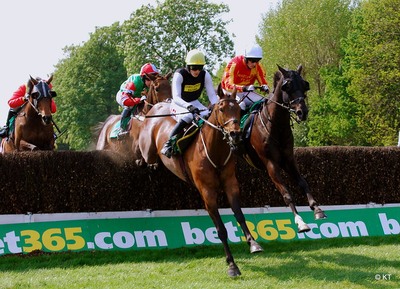
This is where a lot of the famous horses come from.
They aren’t retired as early, reaching their prime around 7 to 10 years old on average and sometimes running for much longer, so the average punter can get to know them a little. Despite this, there is actually less money in jump racing than in flat racing on a race by race basis, although over the longer period of time a successful jump horse can rack up a hefty amount in prize money.
National Hunt season takes place over the wetter months because the ground is usually softer, and this makes it safer for the horse’s delicate legs. It’s for the same reason that a footballer wouldn’t make a sliding tackle in a car park but would happily do so on a grass pitch.
A few of the more famous National Hunt races are:
| Race | Date | Course | First Run |
|---|---|---|---|
| Gold Cup | March | Cheltenham | 1924 |
| Grand National | April | Aintree | 1839 |
| King George VI Chase | December | Kempton Park | 1937 |
As horses gain experience they can progress to racing over much larger fences and races can stretch more than four miles. It’s not uncommon for horses to keep running in these races season after season and still be competing at the age of eleven or more.
National Hunt Grades
Although there are differences between National Hunt and flat racing it’s not super important to understand them in detail, and the basic principle remains the same – a higher rating means a better horse in theory.
The general route for progression is that a horse will start their National Hunt career jumping over hurdles with a minimum distance of two miles. Although, rather confusingly perhaps, horses new to National Hunt racing begin with a National Hunt flat race before their first run over hurdles.
As with flat racing, the crème of the crop are allowed to compete in the top tier of jump racing. The difference in quality between grades here is very subtle, all runners will be superb horses. Handicaps are used but this weight is determined differently for each grade:
| Grade 1 | Grade 2 | Premier Handicap |
|---|---|---|
| Weight for age conditions, previous wins irrelevant, 40 races in total | Weight for age conditions, previous wins considered, 69 races in total | Open handicaps, weight dictated by official rating, 40 races in total |
All graded and Premier Handicap races are class 1 races, so now we come to the lower classes 2-6. Eligibility for these races goes back to the familiar rating system we have already explored but the ratings go higher in National Hunt racing.
It works in the same way though; if a horse puts in good performances then their rating increases. This means a horse doing well in a Class 4 race can move through the ranks and perhaps compete in a Class 2 or 3 race next time out. Whether or not it’ll be good enough to compete at the new higher level is what makes racing so fascinating. If the horse does well then that’s great, if it disappoints then it can go back down in class. It’s a bit like boxing really, you do well in a few fights and then it’s time to see if you can compete in a higher class.
Again, there are various race types within each class, but there are also different races too; steeplechases, hurdles, and National Hunt flats. The minimum prize money can vary quite a lot here, even within each class, so let’s take a look at that alongside the handicap:
| Handicap | Steeplechase Min | Hurdles Min | NH Flat Min | |
|---|---|---|---|---|
| Class 1 | N/A | £27,000-£100,000 | £22,000-£75,000 | £20,000-£25,000 |
| Class 2 | 0-140+ | £22,500-£18,000 | £15,000-£18,500 | £14,000-£20,000 |
| Class 3 | 0-120 & 0-135 | £10,000-£25,000 | £8,300-£20,000 | £8,300-£14,000 |
| Class 4 | 0-100 & 0-115 | £5,800-£11,500 | £5,000-£10,00 | £5,000-£8,300 |
| Class 5 | 0-85 & 0-95 | £3,800-£7,000 | £3,500-£6,000 | £3,500-£5,000 |
| Class 6 | N/A | £1,500-£3,800 | £3,500-£3,500 | £2,400-£3,500 |
Grade Progression
 As an example of how horses go up and down the grades, let’s take a look at the career of Galileo Gold who won the Group 1 race, the 2000 Guineas in 2016. His first race was in Class 3 and he failed to win that one. As a result the two-year-old was dropped down to Class 5 and he won that race. Next up was a step up to Class 4 and another win but the prize money was just over £4,000.
As an example of how horses go up and down the grades, let’s take a look at the career of Galileo Gold who won the Group 1 race, the 2000 Guineas in 2016. His first race was in Class 3 and he failed to win that one. As a result the two-year-old was dropped down to Class 5 and he won that race. Next up was a step up to Class 4 and another win but the prize money was just over £4,000.
With two wins under his belt, a big move up in class took place for his next race. Galileo Gold took part in a Group 2 race at Goodwood, finished in front of the rest of the field and won his owner over £100,000. Since then it’s been a succession of Group 1 races including that win in the 2000 Guineas with a first prize of close to £300,000. He went on to finish second in the Qatar Stakes at Goodwood, losing by a neck, and would have won over half a million pounds had he managed 1st place. A long way away from that Class 5 outing.
Conclusion
As you have just read, there are a lot of different grades/classes in horse racing. It’s not surprising considering there are so many racehorses in training and of such varying abilities.
It’s tough to get your head around, no question, but without all the grades and handicaps, etc. racing would be a much duller sport with less competitive races, resulting in horses with little ability probably not racing at all.
This might be a complicated system (and we only half explored it here), but it does allow the crème to rise to the top, and creates a lot more excitement and engagement for punters, too.
